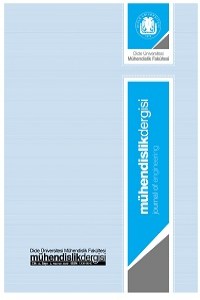Öz
Bu çalışmada;
iki farklı atomizasyon yöntemi (su ve gaz) ile kendinden yağlamalı yatak presleme
amaçlı CuSn10 (bronz) ve Cu (bakır) tozu üretilmiştir. Su atmozasyonu ile
CuSn10 ve gaz atomizasyonu ile Cu tozu üretilmiştir. Su atomizasyonu ve gaz
atomizasyon ile üretilen CuSn10 ve Cu tozlarının ortalama toz boyutu sırasıyla
41.5 µm ve 41,9 µm’dir. Çalışmada üretilen tozlar ve mevcut uygulamada
kullanılan tozlar ile normal presleme (tek eksenli) yöntemiyle kendinden
yağlamalı yatak üretimi gerçekleştirilmiştir. Daha sonra hidrojen ve azot gazı
karışımından oluşan koruyucu atmosfer altında 780 0C sıcaklıkta
farklı bekleme süreleri için sinterleme işlemi uygulanmıştır. Sinterlenen
yatakların yağ alma, hacimsel gözenek oranları ve kırılma dirençleri deneysel
olarak belirlenmiştir. Çalışmada 6,4 g/cm3 yoğunluk, %28 gözenek, 45
ksi radyal mukavemet ve % 96 yağ alma verimi hedeflenmiştir. Bu hedeflerden
yoğunluk ve gözenek miktarı elde edilmesine karşın mukavemet ve yağ alma verimi
hedeflenen değerlere göre düşük kalmıştır.
Anahtar Kelimeler
Destekleyen Kurum
TÜBİTAK
Proje Numarası
5120001
Teşekkür
Desteklerinden dolayı TÜBİTAK Başkanlığına teşekkür ederiz.
Kaynakça
- Gu, S., Zeoli, N., 2006, Numerical Modelling of Droplet Break-Up for Gas Atomisation, Computational Materials Science, vol. 38, no:2 pp. 282.
- Uslan İ, Küçükarslan S., 2010, Kalay tozu üretimine gaz atomizasyonu parametrelerinin etkisinin incelenmesi, Gazi Üniversitesi Mühendislik-Mimarlık Fakültesi Dergisi, cilt 25, no:1, pp.1.
- Uslan I, Saritas S, Davies TJ., 1999, Effects of variables on size and characteristics of gas atomised aluminium powders, Powder Metallurgy, vol. 42, no:2, pp. 157.
- Fedorchenko I. M., Pugina L. I., 1980, Composite sintered antifriction materials (in Russian), Kiev, Naukovadumka, pp. 404.
- Moshkov A. D., 1968, Porousanti friction materials (in Russian), Moskow, Mashinostroenie, pp. 208.
- Eisenkolb F., 1969, Successes of powder metallurgy (translated from Germanlanguage by A. K. Natanson), Moskow, Metallurgia, pp. 540.
- Arnold N. A., Carbon K. C., Straub V. C., 2008, Powder metallurgy bearings, Powder Metal Technologies and Applications, vol. 7, pp. 1051-1057.
- Libenson G.A., 1982, Manufacturing of sintered parts. Text book for technical school (in Russian), Moskow, Metallurgia, pp. 256.
- Kiparisov S.S., Libenson G. A., 1971, Powder metallurgy (in Russian), Moskow, Metallurgia, pp. 528.
- Belov S.V., 1987, Porouspenetrable materials. Reference media. (in Russian), Moskow, Metallurgia, pp. 335.
- Kostornovand A.G., and Fushchich O.I., 2007, Sintered antifriction materials, Powder Metallurgy and Metal Ceramics, vol. 46, no. 9-10, pp. 503–512,
- Kostornov A.G., Fushchich O. I., and Chevichelova T. M., 2007, Structurization in sintering of antifriction powder materials based on iron-copperalloys, Powder Metallurgy and Metal Ceramics, vol. 46, no. 11-12, pp. 589–594.
- Vergheseand R. and Gopinath K., 1989, Influence of antimony additions on sinterediron-copper bearing materials, Key Engineering Materials, vol. 29-31, pp. 457–464.
- Vasil'ev Y. M., Shvetsova G. A., Berent V. Y., and Bushe N. A., 1982, Antifriction properties of an ironbase material containing amanganeseult raphosphate, Powder Metallurgy and Metal Ceramics, vol. 21, no. 7, pp. 592–594.
- Teisanu C. and Gheorghe S., 2011, Development of New PM Iron-Based Materials for Self-Lubricating Bearings, Advances in Tribology, pp: 1-11.
- Uslan İ, Atak Y., Urtekin L., Sarıtaş Ş., 2008, Investıgatıon of The Effects of Parameters to Oıl Impregnatıon Capacıty, 5. International Powder Mettalurgy Conferences, pp. 829.
Ayrıntılar
| Birincil Dil | Türkçe |
|---|---|
| Bölüm | Makaleler |
| Yazarlar | |
| Proje Numarası | 5120001 |
| Yayımlanma Tarihi | 15 Haziran 2020 |
| Gönderilme Tarihi | 12 Kasım 2019 |
| Yayımlandığı Sayı | Yıl 2020 Cilt: 11 Sayı: 2 |


